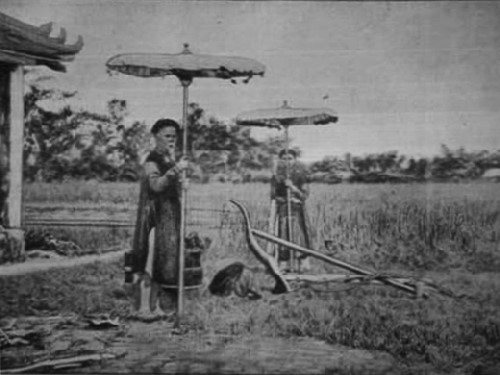Tich dien is a ceremony aiming to encourage locals to focus on rice cultivation and agricultural activities. On this occasion, the Emperor directly ploughs on the field. Emperor Minh Mang realized its importance and assigned the Rite Ministry to carefully prepare relevant documents to use in long-term.
Under the reign of Emperor Gia Long, the ceremony was held in a field in Hoa Thai and Nguong Tri ward, Hue Imperial City. In 1828, Emperor Minh Mang located “Tich dien” field in An Trach and Hau Sinh ward.
Although the ceremony is held in the fifth lunar month, the specific date and time was carefully selected by Rite Ministry and approved by the Emperor in the late fourth lunar month. Five days before the ceremony, staffs, farmers and orchestra members gathered at the field under the monitor of Rite Ministry. The day before the ceremony, Thua Thien phu receives rice, basket and other farming tools at Vo kho (the agency which is in charge of storing things under Nguyen dynasty) before reporting to Bo Ho (Finance Ministry). Approved by Finance Ministry, tools are transported to the “tich dien” field. On the same day, the Emperor arrived at Khanh Ninh Residence to prepare for the ceremony the following day. Ministries namely rites, home affairs and Vo Kho arranged altars, offering things and the resting place for the Emperor. All staffs also attend for rehearsal. Soldiers and elephants stay outside of the surrounding wall. Offering things are adequately arranged. There are also guards standing at the four gates.
Around 3 am to 5am that day, people beat the drum three times. Yellow buffalo, black buffalo, peasants in farming outfits and farming tools are presented at planned positions. Standing on two sides of the fields are 14 singers, 8 instrumentalists and 30 people holding multi-color flags. At this time, the Emperor leaves Khanh Ninh Residence while mandarins and locals stand on their knees to welcome the Emperor along his way. The Emperor then performed the wine offering ceremony. After that, the Emperor moved to Cu Phuc Residence to take off his nine-dragon hat and royal clothes. Informed that the preparation is finished, the Emperor leaves for “tich dien” field. The Emperor plows with a plough on his right hand and a rod on left hand. There are 2 farmers helping the Emperor to lead the buffalo while other 2 people helping the Emperor to hold the plough. Later on, princes and mandarins plow 5 times and 9 times respectively. After that, they bow down 5 times on their knees. When a member of Ministry of Rites declares that the ceremony was completed, the Emperor leaves Quan Canh tower for Cu Phuc Residence to get dress before returning to Khanh Ninh Residence. When the Emperor arrives at the Residence and sits on the throne. The drum is beat five times. Hearing the declaration that the ceremony was completed, mandarins standing on their knees on the court yards start bowing down 5 times.
After the ceremony, the buffaloes are raised by farmers in Phu Xuan commune. Rice, baskets, and ploughs are returned to Vo Kho. Phu Xuan farmers take the responsibility for caring and harvesting rice under the management of Thua Thien Phu. Thua Thien phu cooperated with Ministry of Finance to select seeds for the coming season. The remaining (if any) is used at rites organized at Nam Giao esplanade and shrines.





